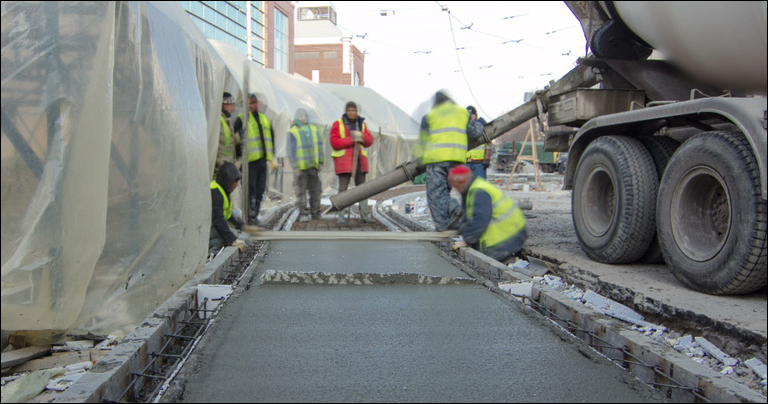MCE finance & leasing market to see robust demand growth
By Edit Team | August 16, 2019 8:37 am SHARE

Demand growth was a robust 24-27 per cent during CY2018, supported by road work throughout the country. Growth stayed strong through the initial 9M of CY2018, barring seasonal lows.
After registering robust demand growth in the past 3-4 years on the back of government’s continued focus on infrastructure investments, the Indian Mining & Construction Equipment (MCE) has hit a mild hiccup due to multiple factors including general elections and liquidity crisis which gripped NBFCs post-IL&FS default. According to industry experts, over 90 per cent MCEs sales depends on financing market, which is largely financed by Non Banking Financial Companies (NBFCs).
The Indian MCE industry is likely to see a moderation in demand growth which is expected to fall to 4-6 per cent in the medium term, more particularly during CY2019, the ICRA predicted in a report released recently. The report on the industry, further noted that demand for MCE post-elections will be a function of a stable government and infrastructure investments. However, the report also indicated long term demand growth to remain robust.
“Demand growth was a robust 24-27 per cent during CY2018, supported by road work throughout the country. Growth stayed strong through the initial 9M of CY2018, barring seasonal lows. However, growth started tapering off in Q4 CY2018 and has been relatively muted in Jan-Feb ’19, impacted partly by the NBFC liquidity crisis, and the consequent impact on loan-to-value (LTV) ratio and interest rates during Q4 CY2018,” said Pavethra Ponniah, Vice President and Sector Head, ICRA.
Mahender Bagrodia, Chief Credit Officer, ABF, Magma Fincorp, said, “Currently the primary market is slow and so is the demand also. The equipment sales are down by more than 20 per cent in first quarter of FY20. There were issues with the contractors where there was abnormal delay of payments by the principals which have negatively impacted the demand for the equipment. However, with stable government at the centre and its repeated focus on infrastructure development, we expect revival in demand.”
Robust demand
Within the MCE industry, the construction equipment (CE) segment has been growing at a rapid pace over the past three years (CAGR of 17 per cent CY16-18E), while the mining equipment (ME) growth has been relatively muted, between 5-10 per cent. “The outlook for ME from late CY19 onwards is expected to be positive but will be largely contingent on Coal India’s massive equipment ordering plans. Coal India has already floated tenders and factoring in a 9-12-month period for delivery of these large capacity equipment, demand for mining equipment should increase in CY2020,” said Ponniah.
Mining equipment manufacturers, ICRA interacted with, have also corroborated this improving outlook for mining equipment with demand coming from coal and quarrying and aggregate demand for roads. Supported by public sector spending on infrastructure, construction activities witnessed healthy YOY growth during 9M FY2019. Road remained the growth engine for the sector, however, there have been some challenges in land acquisition and arrangement of funds for PPP projects. Overall, the construction sector is expected to continue to witness healthy order inflow and pace of execution, in the backdrop of increased investments in the infrastructure sector.
On the financial front, MCE industry-wide revenue growth has been strong in the last three-four years, supported by sharp recovery in demand across most of the product categories. With better utilisation of capacities and improving bargaining power of OEMs aided by favourable demand, the industry profit margins and RoCE have expanded sharply, reaching highs of 14 per cent and 40 per cent respectively during FY2018. Higher operating margins coupled with lower interest costs, on the back of sizeable reduction in debt, have resulted in strong net profit margins. Steady increase in earnings has resulted in generation of strong cash surplus, which was used to reduce debt levels sharply. Accordingly, the industry credit metrics have improved in the last three years. The working capital intensity, too, continues to be comfortable at less than 10 per cent.
NBFCs likely to come out of liquidity peril
It has been observed that in the past few years the Indian Construction Equipment industry grew despite the hiccups of emission norms, GST and demonetisation. This also indicates that finance agencies and firms confidently extended credit to the buyers. Construction equipment finance is mostly driven by NBFCs and post-IL&FS default in late 2018, these NBFCs started facing liquidity crisis, hitting their credit disbursement across the sector. As it is widely being reported, the automobile sector, including commercial vehicles, took the biggest hit in this line.
Nevertheless, industry experts believe that the government, which is a major demand driver, plays a facilitator’s role through policy and regulations. Adding to this, Reserve Bank of India’s (RBI) consecutive efforts to assure liquidity in the finance market would ease cost of finance that would gradually relive the NBFCs.
“The decision to cut down rates was expected owing to the ongoing liquidity crisis and muted economic growth. This said, the RBI has taken the cue from the government’s Union Budget 2019-20, where it gave elbow room for fiscal stimulus to NBFCs. Additionally, the global slowdown followed by the US Fed lowering its rate provided yet another indication to the Central Bank,” said Ramesh Nair, CEO & Country Head, JLL India.
In line with the general market sentiment, the cumulative 110 bps rate cut in the last four policy reviews favours the Indian economy. This month the Central bank reduced the repo rate by 35 bps and continues to maintain an accommodative stance. Rajiv Sabharwal, MD and CEO, Tata Capital on the monetary policy, said, “The markets will draw comfort from the fact that the regulator has emphasised on boosting growth and private investment remains high priority at this juncture. Supplemented by durable liquidity and an effective transmission of rates, the bond market will continue to sustain momentum. Priority sectors are the engines for the growth of the economy and NBFCs play an important role in delivering credit to these sectors. Thus, permitting the banks to on-lend through NBFCs for Agriculture and MSMEs will help further channelise the credit flow effectively to these sectors.
“Various policy initiatives like the Smart City Mission, development of industrial corridors, the Atal Mission for Rejuvenation and Urban Transformation (AMRUT), metro rail projects, Prime Minister Awas Yojana (Urban) and Make in India, have added value to the overall buying sentiments within these markets,” says Samantak Das, Chief Economist and Head of Research & REIS, JLL India.
“The impact of these national-level projects is expected to be long term and will make these cities more attractive destinations for various industries as well as residential real estate. The trend is prominently visible in the peripheral markets of top metro cities,” adds Das.
Liquidity ease to NBFCs would further enable them to extend finance to the priority sectors including infrastructure and equipment sector. “In the present scenario, the problem is more on the demand side than on the funding side. From the funding side we still have NBFC who are active in funding, though the cost of funds are higher. Also banks continue to fund but they are looking more on cash flow comforts now. Overall, the credit worthy customers are still getting funding both from banks and NBFC,” said Bagrodia.
Leasing & renting catching up equipment market
Leasing and renting of construction equipment is yet in a nascent state though manufacturers and dealers are simultaneously looking at increasing the market reach along with direct sales.
“Equipment Rental Market in India is set to grow rapidly in the next 5 years, due to increase in infrastructure spending and need for faster execution of projects. Equipment rental is a convenient way for all the large construction companies or EPC players to supplement their existing fleet and reduce the total time taken to complete a project. They don’t have any hassle of paying EMIs, storage of equipment, maintaining equipment parking yards etc. after completion of the project,” said, Neeraj Sehrawat, Vice President, Indiabulls Store One. Presently, more and more companies are moving towards rental equipment solutions for their project execution needs due to stiff project deadlines and capex constraints.
Rental business in India is evolving and India is having large number of small rental players dominating the market, as compared to developed markets, where large rental players control the major share in the rental business. Due to this, equipment rental yield in India is much lower than other developed countries, which makes it tougher for the larger players to grow and sustain the business. “Apart from this, there is shortage of skilled operators and technicians to operate and maintain the rental fleets, this can be addressed by OEM support to train operators and technician and it will also help to create employment. We are working on these lines to create a trained and efficient workforce to cater the industry requirement in a professional manner,” remarks Sherawat.
Indiabulls Store One is one of the largest rental players in India, which is operating on Pan India basis. Currently, it is offering vast variety of construction equipment on rental such as tower cranes, passenger hoist, material hoists, piling rigs, concrete batching plant, steel automatic stir up machines, transit mixers, wheel loaders, excavators, graders, mobile boom placers and many more. Indiabulls Store One has come up with new machine sales for aerial work platforms. This will include scissor lifts, articulated and telescopic boom lifts. Indiabulls Store One has tied up with international OEMs to offer new machine solution in India. Under new machine sales, we will be growing our portfolio, where our aim is to offer high quality reliable machines with prompt product support. We will be offering sales and service of Aerial Work Platforms from branches located at Mumbai, Delhi, Pune, Ahmedabad and Bengaluru.
The outlook for ME from late CY19 onwards is expected to be positive but will be largely contingent on Coal India’s massive equipment ordering plans.
Pavethra Ponniah, Vice President and Sector Head, ICRA
Currently, the primary market is slow. The equipment sales are down by more than 20 per cent in first quarter of FY20. However, with stable government at the centre and its repeated focus on infrastructure development, we expect revival in demand.
Mahender Bagrodia, Chief Credit Officer, ABF, Magma Fincorp
“Supplemented by durable liquidity and an effective transmission of rates, the bond market will continue to sustain momentum. Priority sectors are the engines for the growth of the economy and NBFCs play an important role in delivering credit to these sectors.
Rajiv Sabharwal, MD and CEO, Tata Capital
Various policy initiatives like the Smart City Mission, development of industrial corridors, AMRUT, metro rail projects, PMAY (Urban) and Make in India, have added value to the overall buying sentiments within these markets.
Samantak Das, Chief Economist and Head of Research & REIS, JLL India
Equipment Rental Market in India is set to grow rapidly in the next 5 years, due to increase in infrastructure spending and need for faster execution of projects.
Neeraj Sehrawat, Vice President, Indiabulls Store One
Cookie Consent
We use cookies to personalize your experience. By continuing to visit this website you agree to our Terms & Conditions, Privacy Policy and Cookie Policy.























































